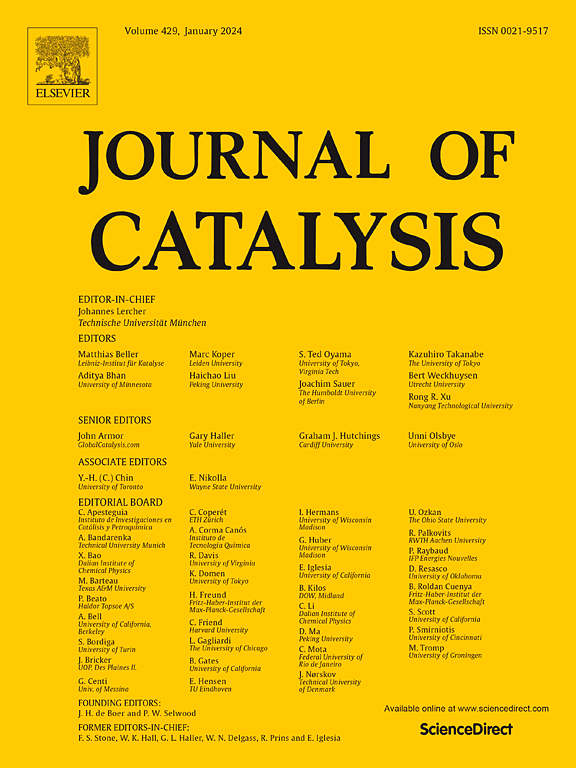Ti-MOF-derived titanium oxide-modified carbon nitride: A Z-scheme heterostructure for the selective photocatalytic cleavage of lignin CC bonds
IF 6.5
1区 化学
Q2 CHEMISTRY, PHYSICAL
引用次数: 0
Abstract
The utilization of solar energy to break the Cα![]() Cβ bonds in lignin under mild conditions is highly important for lignin valorization. This work presents an MIL-125-derived titanium oxide (M-TiO2)-modified carbon nitride (g-C3N4) heterostructure for selective photocatalytic lignin Cα
Cβ bonds in lignin under mild conditions is highly important for lignin valorization. This work presents an MIL-125-derived titanium oxide (M-TiO2)-modified carbon nitride (g-C3N4) heterostructure for selective photocatalytic lignin Cα![]() Cβ bond cleavage at room temperature. The conversion of lignin model 2-phenoxy-1-phenylethanol (PP-ol) reached 90.8 % over M-TiO2/g-C3N4 composites, which is visibly higher than that of bare M-TiO2 (33.2 %) and g-C3N4 (57.3 %). Furthermore, the selectivity of Cα
Cβ bond cleavage at room temperature. The conversion of lignin model 2-phenoxy-1-phenylethanol (PP-ol) reached 90.8 % over M-TiO2/g-C3N4 composites, which is visibly higher than that of bare M-TiO2 (33.2 %) and g-C3N4 (57.3 %). Furthermore, the selectivity of Cα![]() Cβ bond breakage reached 96.8 %, and the yield of benzaldehyde was as high as 86.4 %. A mechanistic study innovatively demonstrated that lignin Cα
Cβ bond breakage reached 96.8 %, and the yield of benzaldehyde was as high as 86.4 %. A mechanistic study innovatively demonstrated that lignin Cα![]() Cβ bond cleavages are achieved by the cooperative effect between holes and 1O2, where holes dominate PP-ol conversion, whereas 1O2 governs Cα
Cβ bond cleavages are achieved by the cooperative effect between holes and 1O2, where holes dominate PP-ol conversion, whereas 1O2 governs Cα![]() Cβ bond cleavages. M-TiO2 has relatively large surface areas and high porosities, and the Z-scheme heterojunctions retard charge carrier recombination and outfit strong redox abilities, which separately prompt O2 adsorption and evolution to generate 1O2, accounting for the high selectivity of Cα
Cβ bond cleavages. M-TiO2 has relatively large surface areas and high porosities, and the Z-scheme heterojunctions retard charge carrier recombination and outfit strong redox abilities, which separately prompt O2 adsorption and evolution to generate 1O2, accounting for the high selectivity of Cα![]() Cβ bond breakages over M-TiO2/g-C3N4 composites. This study sheds new light on the potential of metal–organic framework-derived materials in photocatalysis and provides valuable insights into the photocatalytic cleavage of lignin Cα
Cβ bond breakages over M-TiO2/g-C3N4 composites. This study sheds new light on the potential of metal–organic framework-derived materials in photocatalysis and provides valuable insights into the photocatalytic cleavage of lignin Cα![]() Cβ bonds.
Cβ bonds.

求助全文
约1分钟内获得全文
求助全文
来源期刊

Journal of Catalysis
工程技术-工程:化工
CiteScore
12.30
自引率
5.50%
发文量
447
审稿时长
31 days
期刊介绍:
The Journal of Catalysis publishes scholarly articles on both heterogeneous and homogeneous catalysis, covering a wide range of chemical transformations. These include various types of catalysis, such as those mediated by photons, plasmons, and electrons. The focus of the studies is to understand the relationship between catalytic function and the underlying chemical properties of surfaces and metal complexes.
The articles in the journal offer innovative concepts and explore the synthesis and kinetics of inorganic solids and homogeneous complexes. Furthermore, they discuss spectroscopic techniques for characterizing catalysts, investigate the interaction of probes and reacting species with catalysts, and employ theoretical methods.
The research presented in the journal should have direct relevance to the field of catalytic processes, addressing either fundamental aspects or applications of catalysis.
 求助内容:
求助内容: 应助结果提醒方式:
应助结果提醒方式:


